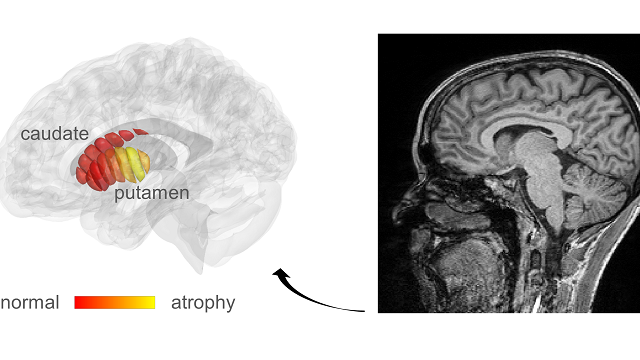
Credit Mezer Lab_MRI images for detection of microstructural changes in early-stage PD patients. In yellow are areas where PD patients show tissue damage, compared to healthy controls.
Hebrew University researchers have developed an early-stage diagnosis of Parkinson’s Disease. The new method uses Quantitative Magnetic Resonance Imaging (qMRI) technology.
That such new methods for medical treatments and the early detection of diseases should not surprise anyone who has followed the daily news coming out of Israel Startup Nation. Israeli firms are at the forefront of new medical technologies and Israeli researchers seem to come up with new medical treatments on almost a daily basis.
And Israelis have been leaders in the world in developing new cancer treatments and early detection tech. For example, in April researchers from Tel Aviv University developed another new treatment for cancer. The researchers proved that a drug delivery system based on lipid nanoparticles can utilize RNA to overcome resistance to both chemotherapy and immunotherapy in cancer treatments.
Please help us out :
Will you offer us a hand? Every gift, regardless of size, fuels our future.
Your critical contribution enables us to maintain our independence from shareholders or wealthy owners, allowing us to keep up reporting without bias. It means we can continue to make Jewish Business News available to everyone.
You can support us for as little as $1 via PayPal at [email protected].
Thank you.
Also, Israeli medtech startup SpotitEarly specializes in the treatment of cancer. The company uses artificial intelligence (AI) to copy the smelling abilities of dogs in its tech, believe it or not.
The Mayo Clinic explains that Parkinson’s disease is a progressive disorder that affects the nervous system and the parts of the body controlled by the nerves. Symptoms start slowly. The first symptom may be a barely noticeable tremor in just one hand. Tremors are common, but the disorder may also cause stiffness or slowing of movement.
As with any such disease, early detection is crucial for treatment. However, there is no cure for it and the new method of detection could help allay symptoms long term by starting the treatments earlier. Also, it gives new images of how the brain is affected by the disease in earlier stages which in and of itself could help lead to the development of better treatments and even a cure some day.
The usual method of visualizing brain structure utilizes a simple MRI. However, it isn’t sensitive enough to reveal the biological changes that take place in the brains of Parkinson patients, and at present is primarily only used to eliminate other possible diagnoses.
The novel method of analysis reveals biological changes in the cellar tissue of the striatum, a part of the deep brain. Developed by Elinor Drori, the doctoral student of Prof. Aviv Mezer, the researchers recognized that the cellular changes in Parkinson’s could possibly be revealed and were able to demonstrate that these changes were associated with the early stages of Parkinson’s and patients’ movement dysfunction.
The new qMRI method enabled HU researchers to look at microstructures within the striatum, an organ which is known to deteriorate during Parkinson’s disease progression. qMRI achieves its sensitivity by taking several MRI images using different excitation energies – similar to taking the same photograph in different colors of lighting. The HU researchers were able to use their qMRI analysis to reveal changes in the tissue structure within distinct regions of the striatum. Until now, the structural sensitivity of these measurements could only have been achieved in laboratories during postmortem examination of patients’ brain cells. — not an ideal situation for early disease diagnosis or monitoring drug efficacy.
“When you don’t have measurements, you don’t know what is normal and what is abnormal brain structure, and what is changing during the progress of the disease,” says Mezer. “The new information will facilitate early diagnosis of the disease and provide “markers” for monitoring the efficacy of future drug therapies. What we have discovered is the tip of the iceberg. It is a technique that they will now extend to investigate microstructural changes in other regions of the brain.”
Furthermore, the team are now developing qMRI into a tool that can be used in a clinical setting. Mezer anticipates that is about three to five years down the line. Drori believes that this type of analysis will enable identification of subgroups within the population suffering from Parkinson’s disease – some of whom may respond differently to some drugs than others. Ultimately, he sees this analysis leading to personalized treatment, allowing future discoveries of drug with each person receiving the most appropriate drug.




